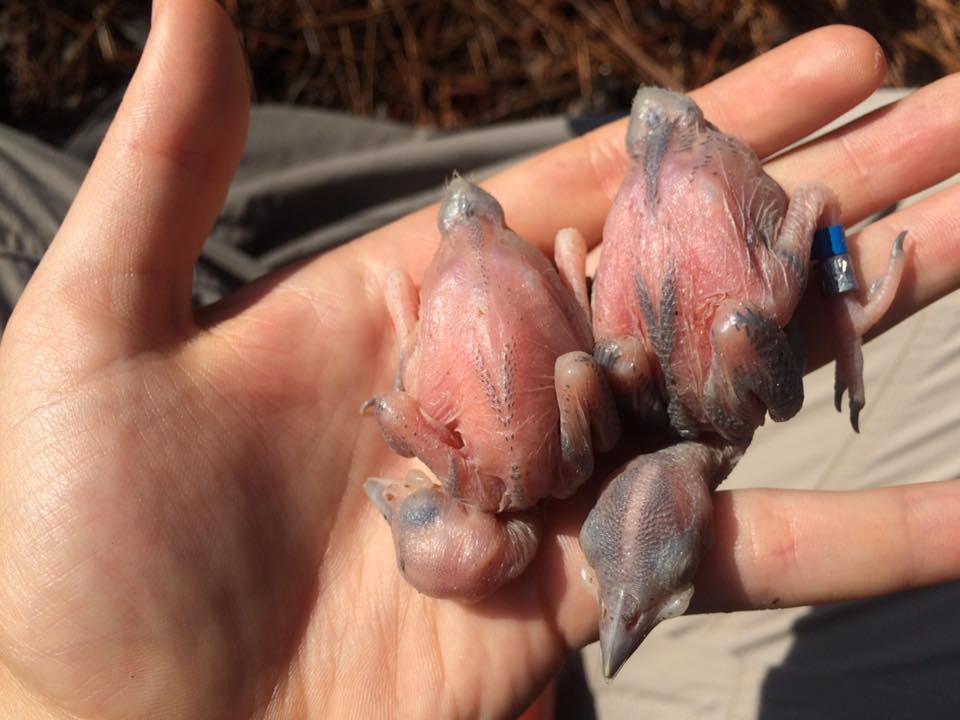By Stephanie DeMay
Linked paper: Variable effects of a changing climate on lay dates and productivity across the range of the Red-cockaded Woodpecker by S.M. DeMay and J.R. Walters, The Condor: Ornithological Applications.
Early in their ecology classes, students learn that plants and animals facing a changing climate have three options: adapt, move, or die. I faced this same choice when I moved to Virginia from the arid West to begin a postdoc at Virginia Tech. There, I experienced a muggier summer than anything I (or my curly hair) was used to. I couldn’t move — I had just started a new job I was really excited about — and dying seemed a bit melodramatic. Ultimately I adapted by, among other things, shifting my outdoor activity to cooler parts of the day. It turned out I was not the only one adjusting the timing of important activities in the face of a different climate: my new study species, the federally endangered Red-cockaded Woodpecker, and I had something in common.
How each species will respond to climate change is a research area full of unanswered questions, with important implications for the world our children, grandchildren, and great-grandchildren will experience. These are not the questions I was hired to answer; my job was to partner with the U.S. Fish and Wildlife Service and lead an analysis of the viability of Red-cockaded Woodpecker populations across their wide range in the southeastern United States. But as part of this effort, our team collected current and historical data from nearly 100 woodpecker populations, including detailed nesting information from about 20 of those, and my coauthor and I knew that we couldn’t let this opportunity to do something more with these data go by. Inspired by this study about the influences of climate on Red-cockaded Woodpecker reproduction in two North Carolina populations, we decided to expand the focus and look for patterns range-wide.
For Red-cockaded Woodpeckers and many other bird species, pairs that nest earlier in spring raise more young than those that take their time getting started. Birds also tend to nest earlier when temperatures are warmer. Our findings agreed with both of these patterns. So if a warming climate causes Red-cockaded Woodpeckers to nest earlier, and earlier nesters fledge more young, does that mean that climate change is wonderful news for Red-cockaded Woodpeckers and their recovery?
Not so fast.

We have to think about why birds might nest earlier in warmer years. Is it because warmer temperatures lead to earlier growth of the plants that feed the insects that feed the woodpeckers? This seems to be the case for some species — earlier nesting is tied to earlier peaks in food availability. If this is also the case for Red-cockaded Woodpeckers, we would expect that when they nest earlier in warmer years, they do so to maintain their normal levels of nesting success. That is, earlier nesting within a year leads to more success compared to late nesting, but nesting earlier across years only maintains previous levels of success. This is what we found… for some populations.
Spring temperatures have warmed over time across the range of the Red-cockaded Woodpecker, but this has not led to earlier nesting in all populations. Coastal and northern populations have been nesting earlier over time. Farther inland, however, this pattern breaks down; some inland populations have even been nesting later over time! Some populations showed patterns that made sense if nesting was shifting to match food (or some other important resource) that is also shifting earlier in the season, but not all. This variability suggests that populations differ in their ability to adjust to a changing climate. We also found that the number of young raised was high and getting better over time at higher latitudes, but worsening over time in the southwestern portion of the range. Could this mean that suitable climate conditions for Red-cockaded Woodpeckers are shifting northward and eastward?
As with most research, we generated 100 new questions for each one we answered. If the area of suitable climate for Red-cockaded Woodpeckers is indeed moving north and east, will the habitat that they depend on be able to shift to keep pace? Are Red-cockaded Woodpecker populations in different parts of their range basing their nesting time on different things, such as food availability, avoiding predators, or avoiding other birds that could kick them out of their nests? By revealing the variability in how different populations respond to climate in different places, our study opens the door for future researchers to dive into this next round of questions. Someone else will have to tackle this, though — I did ultimately leave Virginia and the woodpeckers, though not to escape the climate. I had completed the job I was hired to do and it was time to move on.
Well, okay, maybe ten percent to escape the climate!
